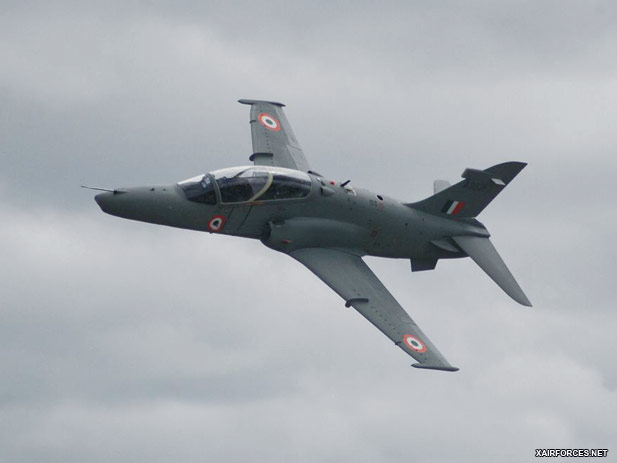
20 More Hawk Mk132 AJTs for Indian Air Force

Bangalore: The proposal of Indian Air Force suggests for new Hawks sanctioned by the defence acquisitions council chaired by defence minister A. K. Antony. The new AJTs costs around 3,600 crore. This will be in addition to the 124 advanced jet trainers (AJTs) previously ordered.
This is the first in three decades, IAF demanded for Hawk AJTs for their ‘transitional training’. Most of the new fighter pilots have to survive with the aged MiG-21 trainers which are already out of place.
Between April 2004 and March 2010, IAF had recorded a total number of 74 air crashes. And out of this 33 was due to human errors while 31 due to technical errors.
Reportedly IAF had faced troubles with its HPT-32’s engine and airframe. It had been blamed due to the lack of required AJTs, a gap has taken place in its instruction program especially when pilots uprooted from Kiran aircraft to MiG-21 supersonic fighter airliner.
Anyway, as India is becoming the largest user of Hawk AJTs today, the move of state-run Hindustan Aeronautics Limited (HAL) to get involved in the production line for the Hawk advanced jet trainers is a much appreciated progress.
Despite of importing a number of 24 Hawks AJTs from BAE Systems, the rest of the AJTs will be manufactured at HAL, Bangalore, an HAL official said. HAL is confident of its potentials to produce full-fledged AJTs in Bangalore. And it looks forward to become the production centre for Hawk advanced jet trainers by future.
This new order of 20 AJTs is to swap ageing aircraft of the Indian Air Force’s (IAFs) crack Surya Kiran Aerobatic Team (SKAT). The Suryakirans are the successor of the Thunderbolts Aerobatic Team. This aerobatic team had been formed in year of 1996. Operating out of Bidar, they perform breathtaking aerobatic practices. The SKATs are known as the Ambassadors of the Indian Air Force and meant to showcase the professionalism, the caliber and the bravery of IAF.
The makeover process in SKAT will be forcefully stopping their awe-inspiring maneuvers in next two Aero India shows of 2013 and 2015. Surya Kiran is the most famed IAF aerobatic team for its Air Shows which conducted in Bangalore every two years.
This Hawk story points out governments’ lack of interest while marking the pitiable long-term scheduling, flawed agreements bonds and overdue delivery schedules. The delay is ``due to receipt of defective components, jigs and fixtures from the foreign manufacturer (BAE Systems), on which liquidated damages were levied'', Antony had previously said.
Government has accused for its delay by telling if they could order the 146 Hawks together, it would be greatly cheaper. And they would not have lost hundreds of fighters and pilots in air crash.
The overall Hawk AJT project is supposed to complete by 2016-17 in an estimated total cost of around 20,000 crore. This project included 24 AJTs direct supply from BAE Systems and 122 will be licenced manufactured by Hindustan Aeronautics Ltd. (HAL) in India. Including the 24 AJTs manufactured by British Aerospace (BAE) Systems Ltd, about 55 Hawks have been introduced until now.
Source: By SiliconIndia, Tuesday, 29 November 2011 - SiliconIndia News (www.siliconindia.com)
Photo: Indian Air Force Hawk Mk132 Advanced Jet Trainer (AJT)
Photo Story:
The HAWK Mk132 advanced jet trainer, built by the state-owned Hindustan Aeronautics Limited (HAL) was today handed over to the Indian Air Force.
India had placed an order to buy 66 Hawks in 2004, with 24 of them to be delivered directly by its manufacturer BAE Systems of England, while the rest would be built by the city-based unit of the HAL. BAE has already supplied 14 such aircraft which are stationed at the Air Force Station at Bidar in Karnataka.
Speaking after receiving the aircraft at the HAL airport here from HAL Chairman Ashok K Baweja, Air Force Chief Air Chief Marshal Fali H Major said a long standing desire of the Air Force to have a high end jet trainer had been fulfilled.
The HAL-built Hawk would now be flown directly to Bidar air base and added to the fleet of other jet trainers, he said.
The induction of Hawk trainer enabled us to shift from sub sonic to super sonic jet training. From HPT-32 to Kiran and MIG-21, which was 'less than a satisfactory' arrangement and we were always looking for a suitable operational and transitional aircraft to introduce our pilots to the complexities of combat flying. Hawk would help IAF to provide a smooth transition from a jet trainer to state-of-the-art fighters of the IAF, he said.
Earlier, HAL Chief Test Pilot Sqn Ldr (Rtd) Baldev Singh gave a breathtaking display of the HAL-built Hawk on an overcast and windy day as he flew in and out of the clouds in both vertical and horizontal positions. (photo by www.bharat-rakshak.com)
(29.11.2011)
|